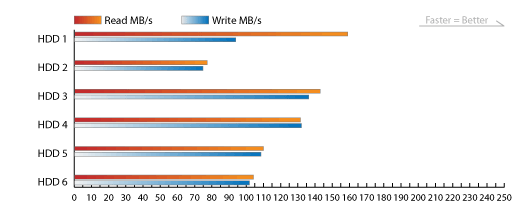FAQ - Frequently Asked Questions - Knowledge Base
What is the actual data transfer rate for USB 3.0?
The actual data transfer rate depends on many different factors. On our website, the data transfer rate that is listed under specifications is always the theoretical value of any given interface. As an example, it may read like this:
- USB 3.0 up to 5Gbps (625MB/s)
- USB 2.0 up to 480Mbps (60MB/s)
The values seen above and any marketing messages like "10 times faster than USB 2.0" are for reference only and are based on the theoretical values. When measuring the actual time it takes to transfer data from the computer to the external hard drive or vice versa, in some cases, the result will be close to the theoretical value but for now, with USB 3.0, in many cases it will be quite a bit less.
The actual data transfer rates may vary for many reasons.
- Chipset
- Hard Drive
- RAID Mode
- Host Controller
- Driver
- Computer
Following is an example of a benchmark that shows the actual transfer speed. Note that the benchmark includes a detailed list showing the host computer, the hard drives and even the software that was used in the test. What this means is that as soon as any of these factors change, the results will likely change as well.
Test Environment
PC: Motherboard GIGABYTE GA-P55-UD4, CPU Intel Core i5 750 @ 2.67GHz, 4GB DDR3 RAM, Windows 7
Host Controller: NEC Electronics USB 3.0 Host Controller v1.0.18.0, FW3021
Test Software: CrystalDiskMark 2.2 (file size 500MB, sequential)
HDD Enclosure: SK-3500 U3 (Fujitsu MB86C30)
- OCZ 60GB SSD (Vertex Series)
- Hitachi 1TB HDD (HDS721010KLA330)
- Hitachi 2TB HDD (HDS722020ALA330)
- Seagate 1.5TB HDD (ST31500341AS)
- WD 1TB HDD (WD1001FALS-00J7B1)
- WD 2TB HDD (WD20EADS-00R6B0)



